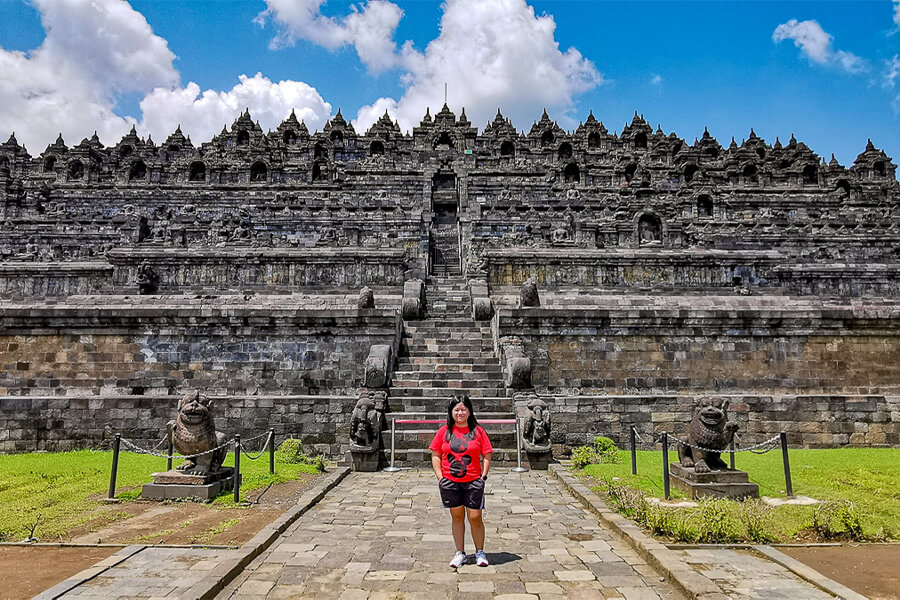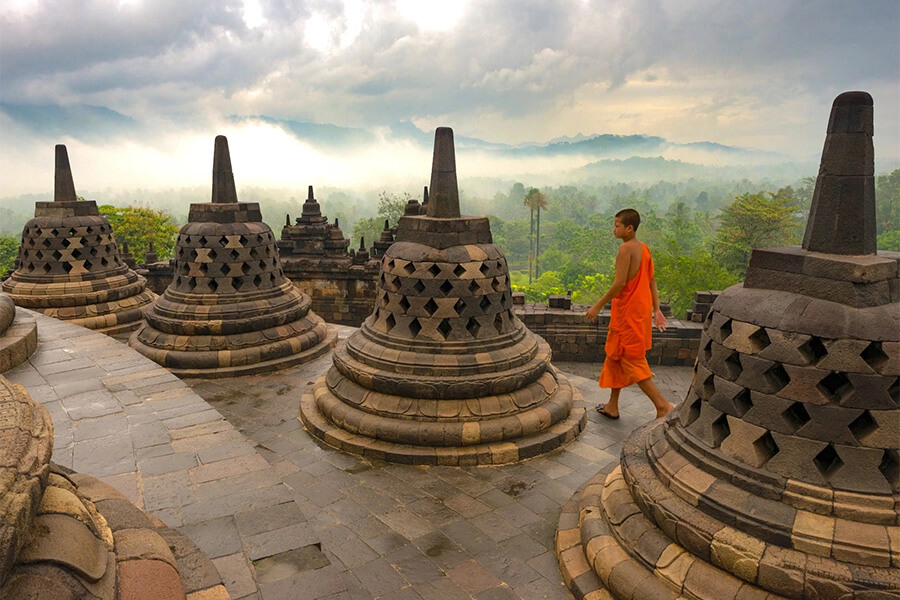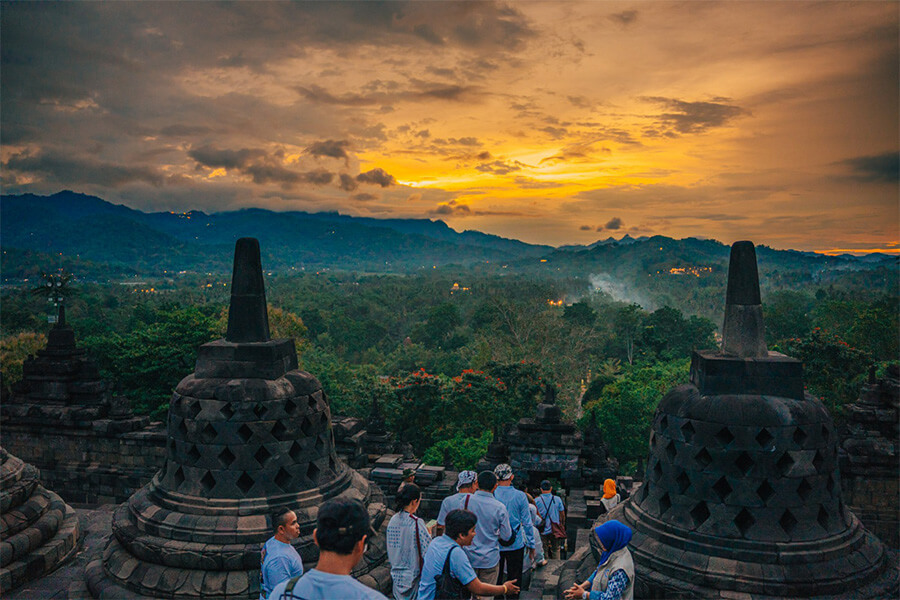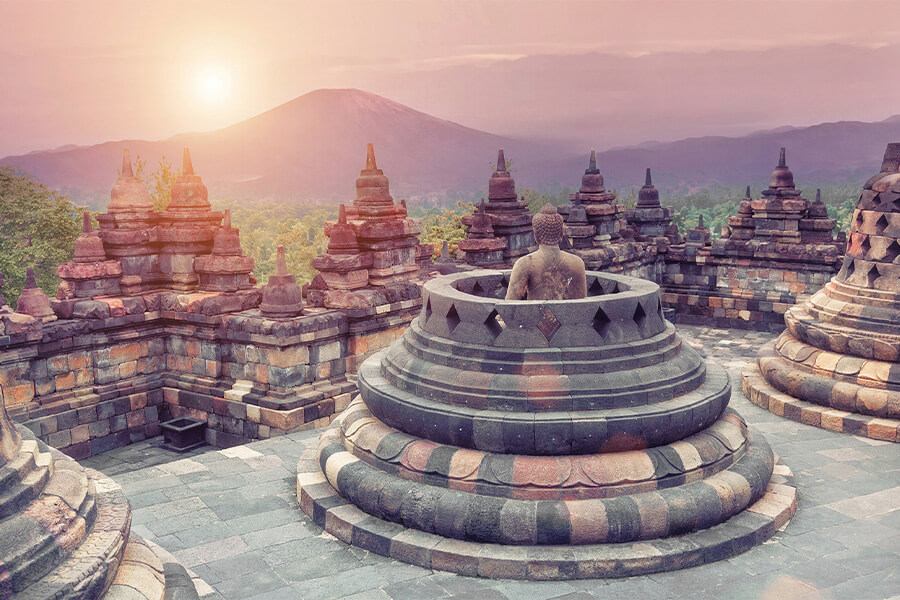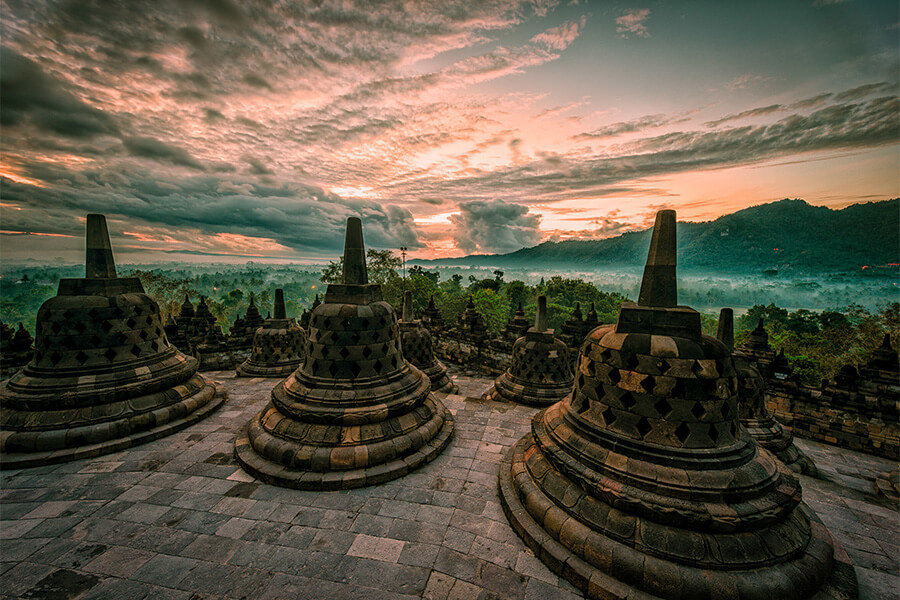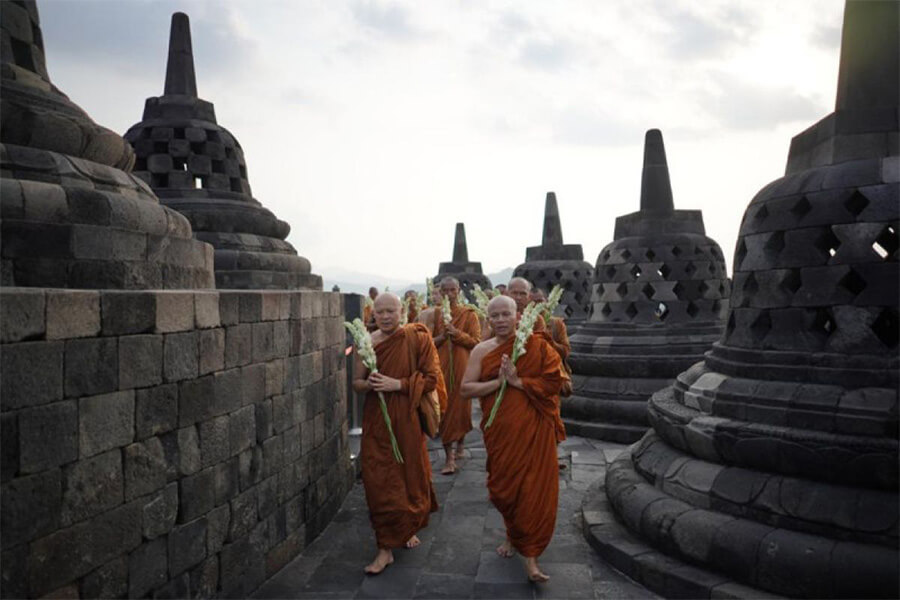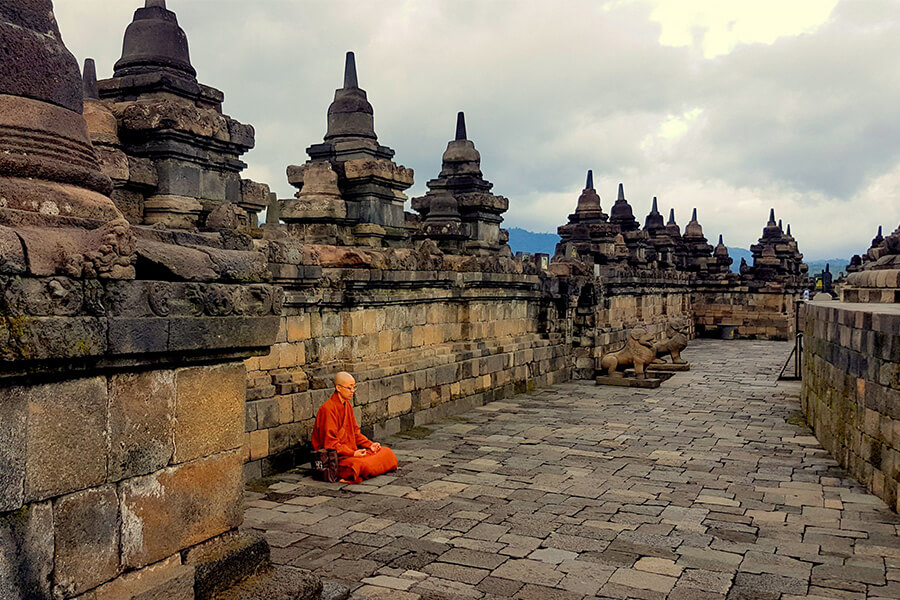If there is one cultural landmark that defines Central Java for many travelers, it is Borobudur temple. Set among rice fields and volcanic hills, this monumental Buddhist sanctuary is more than “just another temple” – it is a spiritual mandala in stone, a masterpiece of ancient engineering, and one of the most important archaeological sites in Southeast Asia.
For travelers, whether you are comparing different Indonesia packages or building your own itinerary, learning how to explore the site properly turns a quick photo stop into a meaningful encounter with Indonesia’s deep history. From understanding the symbolism carved into thousands of relief panels to navigating visiting regulations and conservation rules, planning a visit to the temple of Borobudur is much easier when you know what to expect. This guide brings together expert knowledge, on-the-ground insights, and practical tips to help you experience the site in a respectful, memorable way.
Why Borobudur Belongs on Your Indonesia Itinerary
The Borobudur temple is widely regarded as the largest Buddhist temple in the world and one of the greatest monuments ever built in Asia. For travelers, that scale is immediately obvious: layer upon layer of stone terraces, more than 2,600 carved relief panels, and dozens of bell-shaped stupas with seated Buddhas staring out at a ring of volcanoes in the distance.
Yet what makes the Borobudur Indonesia temple truly special is not just its size, but the way the structure guides you on a symbolic pilgrimage. As you walk clockwise around each level, the reliefs gradually lead you from the world of desire and everyday life toward higher realms of consciousness and enlightenment. It feels less like “touring a monument” and more like participating in a silent, slow ritual.
For anyone exploring Java beyond Bali, the Borobudur temple Indonesia pairs perfectly with nearby Prambanan (a major Hindu temple complex) and the historic city of Yogyakarta, creating a well-rounded cultural circuit that showcases Indonesia’s multi-layered religious and artistic heritage.
Where Is Borobudur and How to Get There?
The Borobudur temple in Magelang lies in the Kedu Plain of Central Java, about 40 km northwest of Yogyakarta and roughly 90 minutes by car from the city center. It sits between volcanic peaks and is bordered by the Progo and Elo rivers, giving the surrounding landscape a lush, fertile feel that has earned it the nickname “the garden of Java.”
Most visitors reach the Borobudur temple Java area in one of three ways:
- Day tours from Yogyakarta: The most common option. Many local agencies and hotels offer shared or private tours that depart early in the morning, stopping at Borobudur temple and sometimes Prambanan on the same day.
- Private car and driver: Ideal if you want flexibility to arrive before the crowds, visit smaller nearby temples (like Pawon and Mendut), or stop at viewpoints and villages along the way.
- Public transport & ride-hailing: More time-consuming but budget-friendly. You can take a bus or minivan toward Magelang and then continue by local taxi or ride-hailing app to the Borobudur Indonesia temple complex.
If you are planning a wider Java journey, many overland tours connect Jakarta, Bandung, Yogyakarta, Borobudur temple, and Mount Bromo, allowing you to experience Indonesia’s cultural heartland at a measured pace.
A Short History of the Temple of Borobudur
Historians believe the temple of Borobudur was constructed in the 8th–9th centuries during the Sailendra Dynasty, when Mahayana Buddhism flourished in Central Java. Built from roughly 55,000 cubic meters of andesite stone, the monument originally functioned as both a shrine to the Buddha and a place of pilgrimage. Pilgrims would ascend from the base to the summit, reading the carved stories and meditating at each level as they symbolically moved closer to enlightenment.
Over time, political and religious shifts – including the rise of Hindu kingdoms in East Java and the gradual Islamization of the island – led to the site’s abandonment. Hidden under volcanic ash and jungle, the Borobudur temple was largely forgotten until the early 19th century, when Sir Thomas Stamford Raffles, then British governor of Java, ordered an investigation and partial clearing of the ruins.
Extensive restoration work took place in the 20th century, culminating in a major project from the 1970s to the early 1980s that stabilized the structure, cleaned the reliefs, and improved drainage. In 1991, the Borobudur temple in Indonesia and its surrounding temple compounds were officially inscribed as a UNESCO World Heritage Site for their outstanding universal value.
Architecture & Symbolism: Reading the Stone Mandala
At first glance, the temple Borobudur Indonesia looks like a stepped pyramid, but the design is actually a sophisticated three-dimensional mandala representing the Buddhist cosmos. The monument is divided into three main realms:
- Kamadhatu (world of desire): The buried base, with reliefs illustrating the workings of karma and the consequences of attachment.
- Rupadhatu (world of forms): Five square terraces with narrative panels depicting episodes from the Buddha’s life and various Jataka tales, along with hundreds of Buddha statues in niches.
- Arupadhatu (formless world): Three circular terraces topped by 72 perforated stupas containing seated Buddhas, culminating in a large central stupa at the summit.
Walking around the Borobudur temple, you’ll notice that the reliefs consistently guide visitors clockwise (the pradakshina direction), keeping the temple to the right – a common ritual practice in Buddhist and Hindu pilgrimage traditions.
The structure’s alignment with the surrounding landscape is equally intentional. From the upper terraces of the Borobudur temple Java, you can see volcanoes on clear days, highlighting how ancient Javanese architecture often merged cosmology, geography, and spirituality into a single, integrated vision of the universe.
What to Expect When Visiting Borobudur Today
In recent years, Indonesian authorities have implemented stricter visitor management policies at the Borobudur temple to protect the fragile stonework from erosion and overcrowding. Measures such as controlled group sizes, time-limited access to the upper terraces, and the use of special footwear are part of a long-term conservation strategy.
While regulations can change, visitors can generally expect:
- Ticketing zones: There is a difference between a park entrance ticket (access to the grounds and viewpoint areas) and a separate ticket that allows you to climb onto the monument itself. Always check the latest information before you go.
- Mandatory guides: Small groups are often accompanied by licensed local guides when accessing the main levels of the Borobudur temple. This protects the site and enriches your understanding with expert commentary.
- Time slots & quotas: Daily visitor caps and timed entries help prevent overcrowding at peak hours, especially on weekends and during domestic holidays.
- Footwear rules: In some periods, visitors are asked to wear special sandals to minimize wear on the stone steps, similar to practices at other major heritage sites.
Despite these restrictions, the overall experience of the Borobudur temple Indonesia remains deeply moving: the soft morning light on volcanic stone, the quiet hum of prayers during Buddhist festivals, and the panoramic views over mist-laced rice fields all combine to create a sense of timelessness.
Best Time to Visit and How Long to Stay
Central Java has a tropical climate, with relatively consistent temperatures year-round but a marked wet season. For most travelers, the best time to visit the Borobudur Indonesia temple is during the dry or shoulder months (roughly May to September), when skies are clearer and sunrise views are more reliable.
Key timing tips:
- Sunrise visits: A classic way to experience the Borobudur temple is to arrive before dawn, either for sunrise inside the temple zone (when available) or from nearby hills and viewpoints. Early morning light emphasizes the relief carvings and usually brings cooler, more comfortable temperatures.
- Golden hour & late afternoon: If you prefer to avoid early starts, late afternoon visits can also be beautiful, with long shadows and softer light. Do keep an eye on closing times and allow enough hours to explore.
- How long to allow: Most travelers spend around 2–3 hours at the monument itself, but if you are deeply interested in the art and stories carved into the stone, you could easily spend half a day exploring the temple of Borobudur and its on-site museum.
Practical Tips for Visiting Borobudur Temple
Thoughtful preparation can make your trip to the Borobudur temple smoother and more rewarding. Consider the following recommendations, often shared by experienced tour leaders and local guides:
- Dress respectfully: As a functioning religious site, modest clothing is expected. Shoulders and knees should be covered. Sarongs are sometimes provided at the entrance, but it’s wise to bring a light scarf or shawl.
- Footwear: Wear comfortable shoes or sandals suitable for climbing stairs. If special slippers are required on the monument, you’ll be instructed at the entrance.
- Hydration & sun protection: Bring water (in a reusable bottle), sunscreen, and a hat; there is little shade on the upper levels of the Borobudur temple.
- Photography etiquette: Photography is generally allowed, but avoid using flash close to the reliefs, don’t climb on stupas or statues, and be mindful not to block narrow pathways for extended photo sessions.
- Respect rituals: If you visit during Vesak or other ceremonies, remember that for many Indonesians the Borobudur temple in Indonesia is first and foremost a sacred space, not just a tourist attraction. Keep noise low and avoid intrusive photography.
Combining Borobudur with Other Central Java Highlights
While the Borobudur temple alone justifies a trip to Central Java, the surrounding region offers a rich cluster of attractions. Many visitors choose a full-day itinerary that includes:
- Pawon and Mendut temples: Two smaller but historically linked temples aligned in a straight line with Borobudur temple. Their simpler, more intimate scale provides a nice contrast to the main site.
- Prambanan: A stunning 9th-century Hindu temple complex dedicated to the Trimurti (Brahma, Vishnu, Shiva), located east of Yogyakarta. When combined with the Borobudur temple Java, it highlights the coexistence of Buddhist and Hindu traditions on the island.
- Village cycling or jeep tours: Many tour operators offer cycling routes through surrounding rice fields or jeep trips to hilltop viewpoints, giving you a glimpse of everyday rural life in Magelang Regency.
- Yogyakarta city: The cultural capital of Java, known for its kraton (sultan’s palace), batik workshops, and lively street food scene, is the best base for visiting the Borobudur Indonesia temple.
If you have more time, extending your stay with visits to Mount Merapi, Dieng Plateau, or even overland journeys toward East Java’s volcanic landscapes makes for a rewarding, in-depth exploration of the island.
Choosing the Right Tour or Experience
There is no single “right” way to experience the Borobudur temple. The best option depends on your interests, budget, and schedule. Here are the main choices:
- Independent visit with local guide: Buy your ticket, then hire a licensed guide at the entrance. This offers flexibility in timing and depth of explanation while directly supporting local professionals.
- Group tours: Suitable for budget travelers or those who prefer a structured day with transport, tickets, and guiding bundled together. Be sure to check group size; smaller groups usually mean a more personal experience at the temple Borobudur Indonesia.
- Private cultural or photography tours: Ideal for travelers who want to focus on specific themes (architecture, history, spirituality, or photography). These tours often start very early, position you at viewpoints at the best times, and allow extra time for detailed exploration of the relief panels.
- Multi-day Java itineraries: For a deeper dive into Central Java, some operators offer multi-day tours that combine the Borobudur temple Indonesia with Prambanan, Yogyakarta, village homestays, and volcanic landscapes.
When choosing a provider, look for transparent pricing, clear information about what is included (tickets, local guide, meals), and responsible tourism practices that respect both the monument and the local community.
Responsible Travel at Borobudur
As visitor numbers grow, the long-term preservation of the Borobudur temple depends partly on traveler behavior. Heritage authorities regularly highlight issues such as worn-down stairs, vandalism, and litter as threats to the site’s integrity.
You can help by:
- Sticking to designated paths and avoiding climbing on stupas or statues.
- Not touching or rubbing relief panels – oils and friction gradually damage the stone.
- Following all staff and guide instructions regarding footwear and access to upper terraces.
- Refusing to buy or support any trade in artifacts; genuine antiquities should never be sold.
- Supporting local businesses outside the complex (restaurants, homestays, handicrafts) that operate ethically and sustainably.
Approaching the Borobudur temple in Indonesia as a living heritage site rather than a backdrop for quick photos not only deepens your experience but also contributes to the monument’s future.
Why Borobudur Deserves Your Time and Attention
Whether you are an architecture enthusiast, a photographer chasing misty volcano views, or a traveler seeking spiritual depth, the Borobudur temple offers a rare combination of visual drama and quiet introspection. Few places allow you to physically “walk through” an entire philosophical worldview carved into stone – from the everyday chaos of human desire to the serene emptiness of the upper stupas.
As you circle the terraces of the temple of Borobudur, reading panels that have survived more than a thousand years of political change, volcanic eruptions, and shifting religions, it becomes clear why this site holds such powerful meaning for Indonesians and visitors alike. The Borobudur temple in Magelang is not just a must-visit attraction in Indonesia; it is a reminder of how human creativity and faith can shape the landscape itself.
Plan ahead, travel respectfully, and give yourself enough time to explore both the monument and its surroundings. Done right, a visit to the Borobudur Indonesia temple will be one of the most memorable experiences of your journey through Indonesia – a highlight that lingers long after you’ve left Central Java behind.

